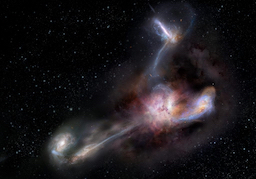Hot dust-obscured galaxies (Hot DOGs) are a previously unknown population of high redshift galaxies at z>1 recently discovered by the NASA's WISE mission. The bolometric luminosities of Hot DOGs are extreme, exceeding those of 1013 Suns. This outstanding energy output is thought to be powered by accretion onto supermassive black holes (SMBHs) buried under enormous amounts of gas and dust, making Hot DOGs close to Compton-thick in the X-rays. Their host galaxies are detected in the near-infrared by Spitzer, but are less massive than expected from such hyper-luminous active galactic nuclei, which implies that either the SMBH has a much larger mass than expected given the stellar mass of its host, or it is radiating well above the limit dictated by the isotropic balance between gravity and radiation pressure. Such luminous nuclei harbored by otherwise normal galaxies are likely at a key stage of their evolution, where feedback from the active nucleus may be quenching star-formation – a “quasar” phase that some theoretical models require in order to explain the star-formation and inter-stellar medium (ISM) properties of red, compact, and mostly quiescent galaxies already identified at cosmic noon, z~2. Our group uses the Atacama Large Millimeter/sub-millimeter Array (ALMA), the largest radio telescope in the world, to characterize the impact the central SMBH has on the ISM of its host galaxy. In addition, the 3D (2D spatial sky-projection + frequency) nature of ALMA's interferometric observations allow us to study the environment of these obscured quasars and search for companion galaxies and signatures of mergers, as Hot DOGs live in over-dense regions likely located at the nodes of the filamentary cosmic web.
Recent Selected Publications:
- "Kinematics and star formation of high-redshift hot dust-obscured quasars as seen by ALMA": Díaz-Santos, T., Assef, R. J., Eisenhardt, P. R. M., Jun, H. D., Jones, G. C., Blain, A. W., Stern, D., Aravena, M., et al. 2021, A&A, 654, 37
- "Hot Dust-obscured Galaxies with Excess Blue Light": Assef, R. J., Brightman, M., Walton, D. J., Stern, D., Bauer, F. E., Blain, A. W., Díaz-Santos, T., Eisenhardt, P. R. M., et al., 2020, ApJ, 897, 112
- "The multiple merger assembly of a hyperluminous obscured quasar at redshift 4.6": Díaz-Santos, T., Assef, R. J., Blain, A. W., Aravena, M., Stern, D., Tsai, C. -W., Eisenhardt, P., Wu, J., Jun, H. D., Dibert, K., Inami, H., Lansbury, G., Leclercq, F., 2018, Science, 362, 1034
- "Eddington-limited Accretion in z ∼ 2 WISE-selected Hot, Dust-obscured Galaxies": Wu, J., Jun, H. D., Assef, R. J., Tsai, C-W., Wright, E. L., Eisenhardt, P. R. M., Blain, A., Stern, D., Díaz-Santos, T., et al., 2018, ApJ, 852, 96
- "The Strikingly Uniform, Highly Turbulent Interstellar Medium of the Most Luminous Galaxy in the Universe": Díaz-Santos, T., Assef, R. J., Blain, A. W., Tsai, C.-W., Aravena, M., Eisenhardt, P., Wu, J., Stern, D., Bridge, C., 2016, ApJ Letters, 816, 6

